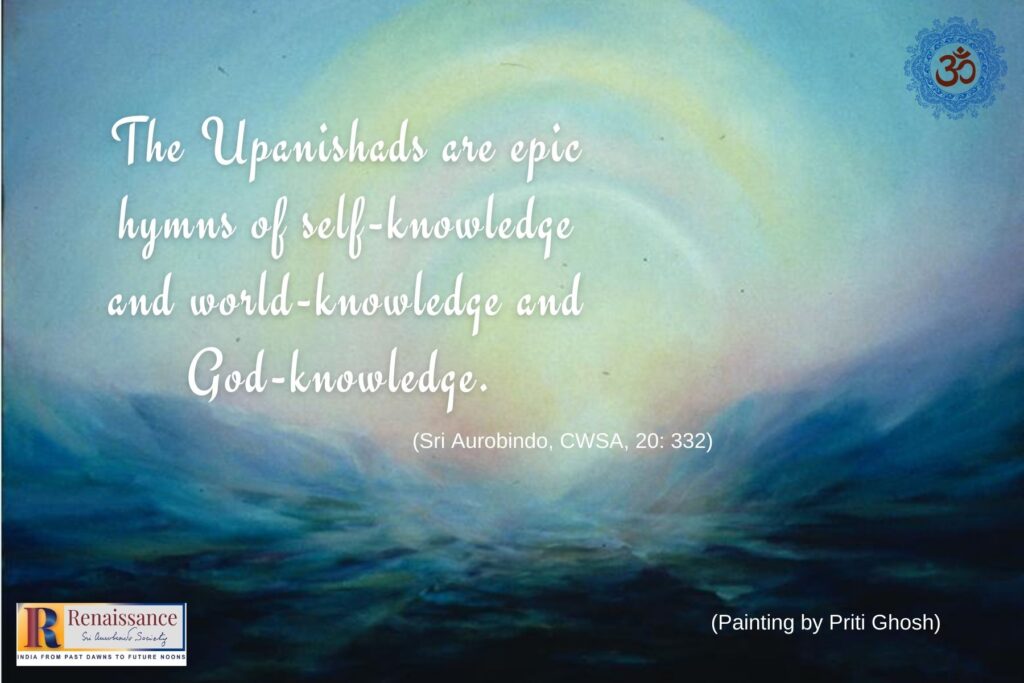Volume VI, Issue 1
Author: Beloo Mehra
Continued from PART 1
After experiencing some of the splendour that fills the compound of Swamy Veerabhadra Temple, let us proceed toward the interior of the mandir.

As noted earlier, according to the earliest inscriptions available, the present temple is about 500 years old, built in 1533. But the tradition maintains a much longer existence. Rishi Agastya who is believed to have stayed here in a cave on the Kurmashila (tortoise shaped hill) had built a small temple dedicated to Lord Shiva. The present-day mandir stands on top of the same Kurmashila hill.
One uniqueness of this temple built in Vijayanagara style is that it has no foundation. The mandir has three sections typically seen in Dravidian style: a large, open hall called mukha mandapa or natya mandapa or ranga mandapa which served as the assembly hall; ardha mandapa or antarala or the ante chamber; and the garbhagṛha or the sanctum sanctorum. The antarala is surrounded by a pradakshina, and the mukha mandapa has a pillared corridor.
The main temple is encircled by two enclosures. The outermost walled enclosure has three gates. This enclosure has covered porches which served as resting places for devotees coming from far off distances.

The temple has three gates. The devotees regularly use the northern gate adorned with a gopuram. In front of the gopuram is the majestic dhwaja stambha. One walks a little to get to the eastern gate on the second walled enclosure; from there a short flight of stairs leads one to the mukha mandapa or natya mandapa.
The Sculpted Pillars
Entering the mukha mandapa one is awestruck by the high carved ceiling and the profusion of beautiful, ornate sculptures. On some parts of the ceiling are sketchy remains of what may have been once glorious paintings.
Lepakshi temple is also famous for its exquisite frescoes and murals, many of which are found in the ardha mandapa. We shall explore some of these paintings in the final part of this series. Let us first enjoy some of the marvelous sculptural art.



There are 70 pillars in this mandapa, and each pillar is ornately carved on all four sides. On most pillars we see a different image on each side, but these images are generally all part of a story. As you walk around the pillar, you are actually witnessing a story carved in stone.

The pillars have carved images of various Gods and Goddesses, including several avatars and rupa-s of Lord Shiva, and various other vibhutis, divine beings, saints, guardians, musicians, dancers and warriors.
“An assured history of two millenniums of accomplished sculptural creation is a rare and significant fact in the life of a people. This greatness and continuity of Indian sculpture is due to the close connection between the religious and philosophical and the aesthetic mind of the people.”
~ Sri Aurobindo, CWSA, Vol. 20, p. 288

Bhikṣāṭana Shiva
One of the most exquisitely carved pillars in the mukha mandapa tells the story of Lord Shiva in his Bhikṣāṭana rupam.
The story goes like this. Lord Shiva in his terrifying Bhairava form had once severed Brahma’s fifth head to help him get rid of his arrogance. As an atonement for this act, Shiva then becomes a mendicant wandering in the forest, naked, begging for alms.
In the natya mandapa of the Veerabhadra temple, the four-armed Bhikṣāṭana Shiva with matted hair is shown wearing ornaments covering his body. He holds a damru and a kapala in his two hands. The heeled sandals in the mūrti also help us identify this form of the Lord. We also see a deer and a gana carrying a basket on his head accompanying Shiva. On the side of the pillar, we see a woman reaching out to the mendicant Shiva. Her clothes are somewhat dishevelled but she doesn’t seem to be aware of it.
There is another interesting story behind this image of the woman. When Lord Shiva roamed the forests in the form of a mendicant, his ascetic form was so endearing that the wives of the forest-dwelling rishis would get highly enamoured of him. They would leave their homes and their husbands, and begin to follow this mendicant Shiva. There is, however, a deeper sense behind similar stories found in several Puranas. That is to establish the Supreme Divinity of Lord Shiva and to humble and enlighten the sages who had become too arrogant and proud of their knowledge.
On another pillar, we meet Shiva as Nataraja. How can a natya mandapa not have the Lord of Dance!

“Nataraja, the Dancing Shiva…the self-absorbed concentration, the motionless peace and joy are within, outside is the whole mad bliss of the cosmic movement.”
~ Sri Aurobindo, CWSA, Vol. 1, p. 584
Shiva is not only the Lord of Dance, he is also the Divine Musician here at Lepakshi. We see him playing the mridangam and a harmonium.
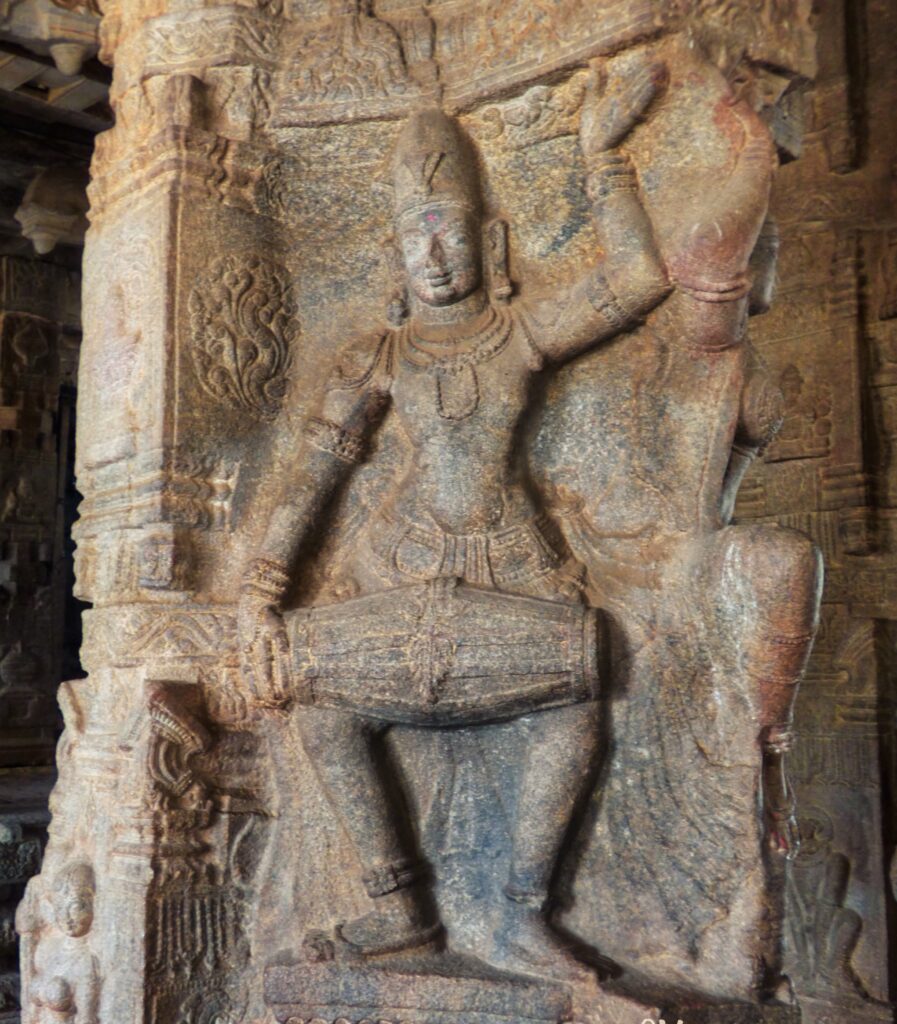
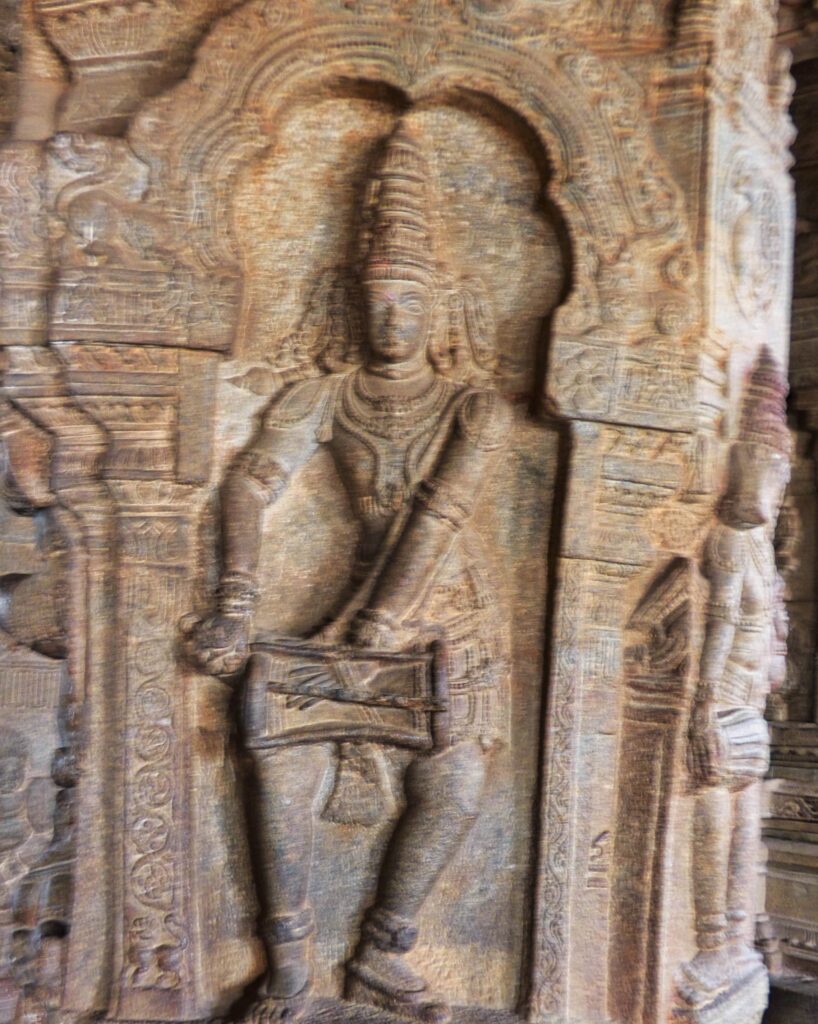
Bhringi’s Love for Shiva
On another pillar we find a beautiful sculpture of sage Bhringi. He was a great devotee of Shiva, and was blessed with three legs by the Lord. Sage Bhringi is also believed to be the ‘Dance Master of the Gods’ and is associated with many nritya mūrtis of Shiva. One such beautiful depiction is seen at the natya mandapa of Sri Veerabhadra Swamy temple at Lepakshi.
The story goes that there once lived a sage named Bhringi whose love and bhakti for Shiva knew no bounds. He used to offer his prayers exclusively to Lord Shiva and completely ignore Mā Pārvati. After observing this for some time, the Goddess decided to teach the sage that She, the Shakti, and Lord are indeed One Consciousness.
One day when Bhringi came to offer his prayers, Mā Pārvati was seen seated on the lap of Lord Shiva. He was dumbstruck at this situation for a few moments. But then using his yogic powers he transformed himself into a snake. This way he could do his devotional pradikshinā only around the Lord by slithering through the gap between Him and the Goddess.
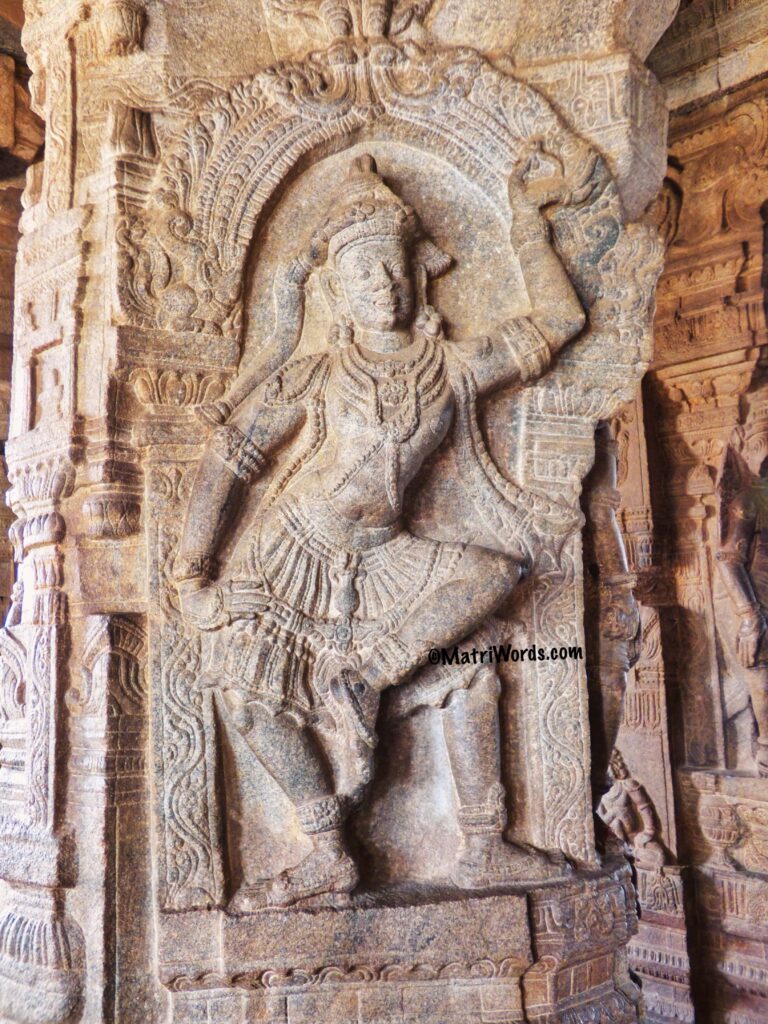
Bhringi – the three legged sage who also conducts the ceremony when Shiva performs his Tāndava
Hurt by the sage’s behaviour Mā Pārvati asked Lord Shiva, “When you and I are one, why does Bhringi ignore me and offers prayers only to you? Does he not realise that Shakti is one with Shiva?” The benevolent Lord comforted his consort and reminded her that she should not be bothered by Bhringi’s childish behavior.
The Two Who are One
Next day, before the sage’s arrival, Shiva unites with Pārvati and thus the Two emerge in One form of Ardhanārishvara. On seeing this splendid form of the Lord, Bhringi was again confused for a little while. But then using his yogic powers he took the form of a bee (some say it was a beetle). In this tiny form, he could now bore a hole through the navel of Ardhanārishvara and go around Lord Shiva’s half only, avoiding the Goddess again. This is what gave him the name Bhringi, which means a bee or a beetle.
Mā Pārvati was now enraged and cursed the sage which made him lose all those parts of his body which he received from his mother, especially the flesh, blood and muscles. He fell down at the feet of Shiva and realised the power of the Goddess. The Lord in his infinite compassion blessed his ardent devotee with a third leg which could provide support to his body. Bhringi, having seen the force of Shakti and experienced the mercy of the Lord, danced out of joy and praised both the God and Goddess, realising the Oneness of Shiva and Shakti.
More Beauties
One can spend hours admiring the beauty that abounds at this magnificent natya mandapa, the dancing hall of the temple. Here are a few more that caught our attention.
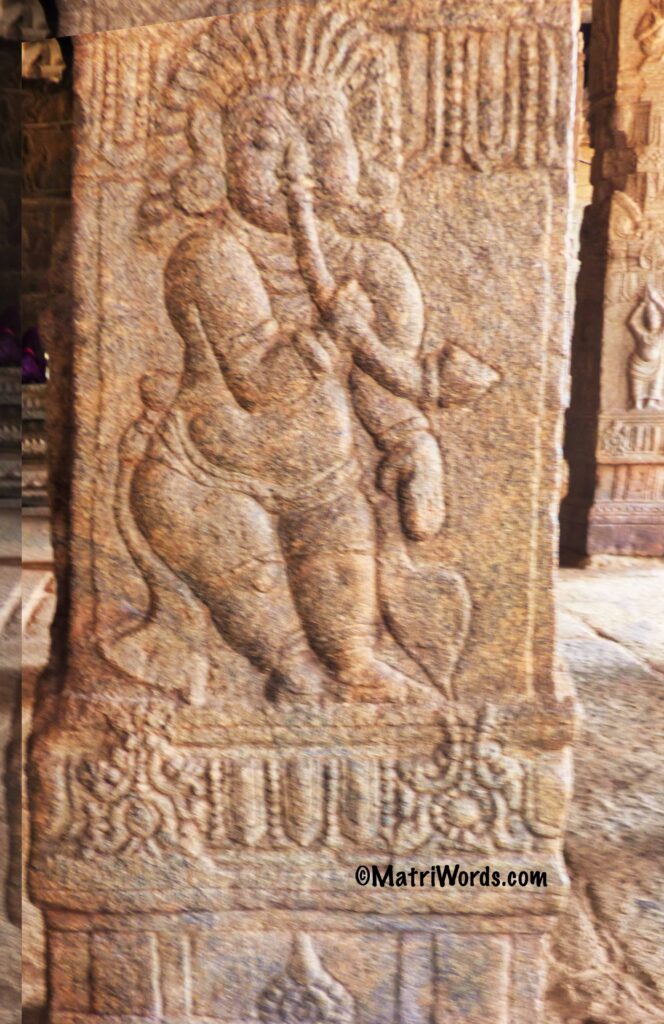
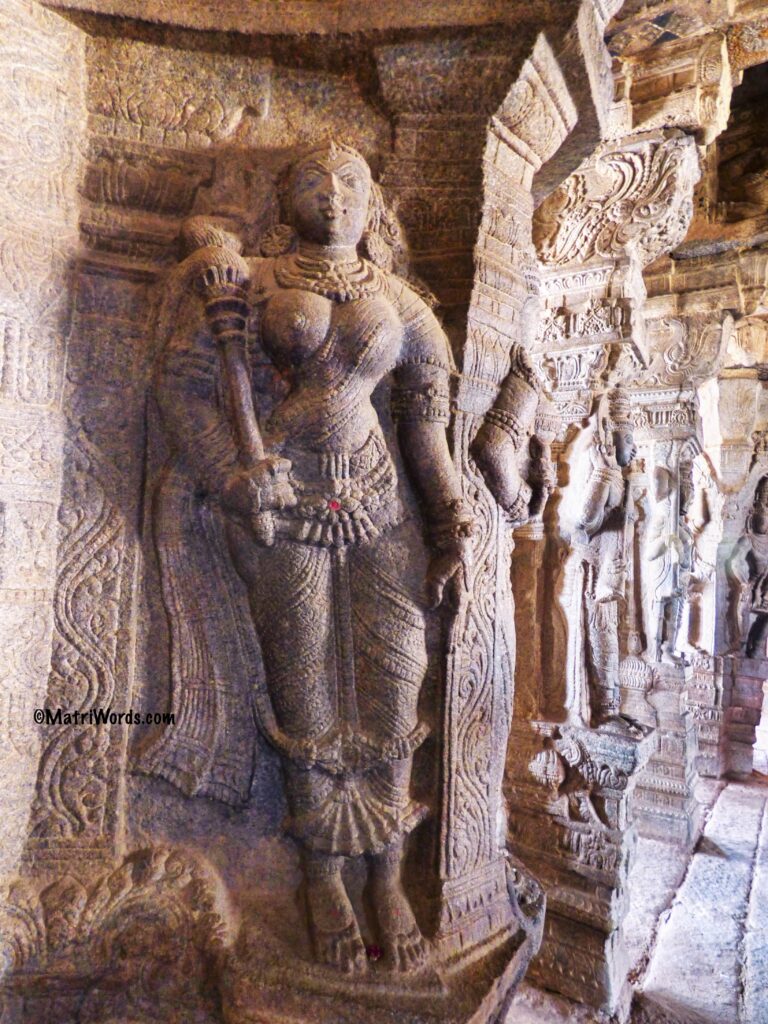
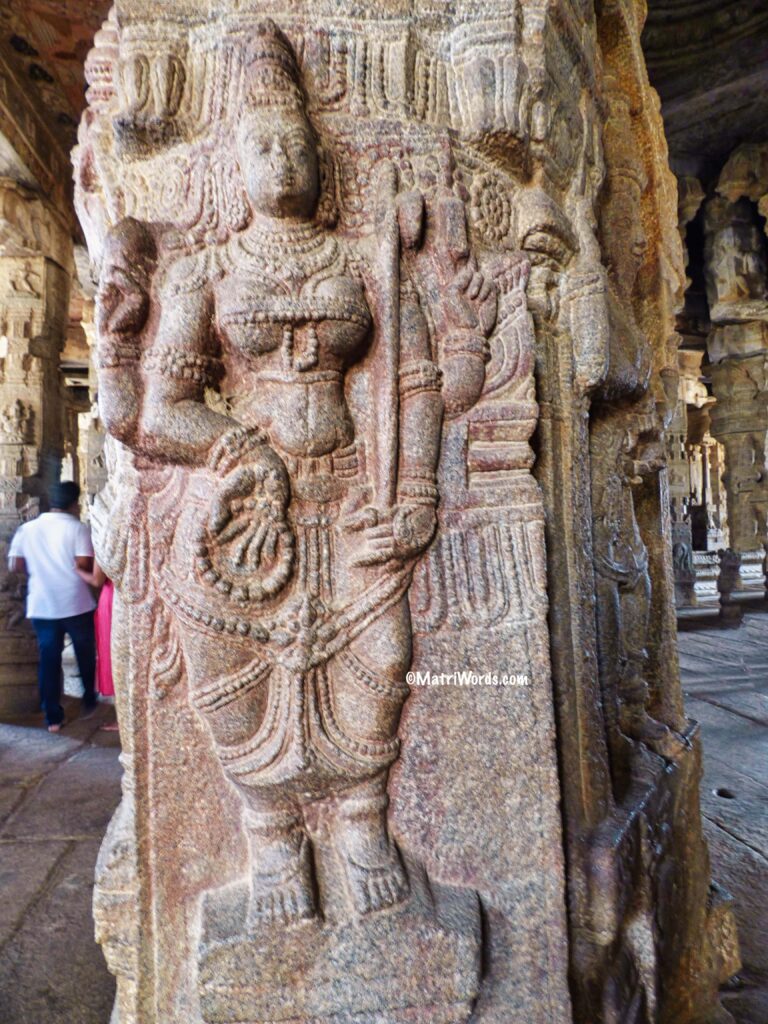
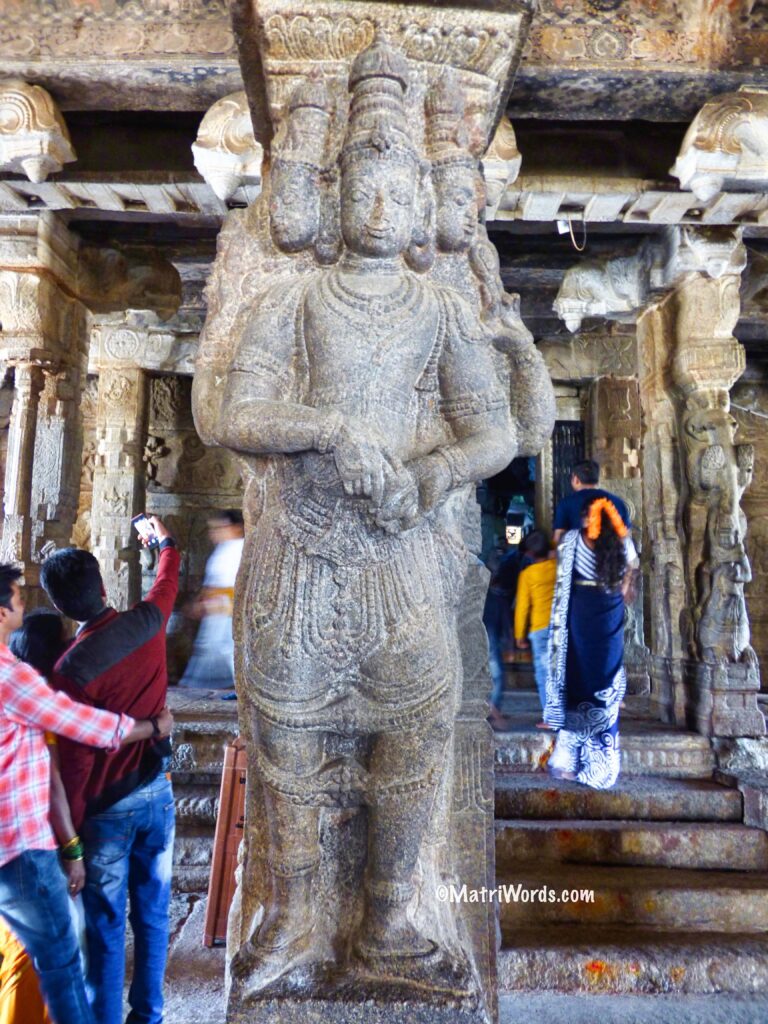

Inside the garbhagṛha resides the main deity of this mandir. We see there a near life-size image of Swamy Veerabhadra, the fiery Shiva, fully armed and decorated with a garland of skulls. No photography is allowed in the garbhagṛha, of course.
There is also a cave chamber inside where Rishi Agastya is said to have lived when he installed a Shivalinga at this site.
Hanging Pillar
The temple at Lepakshi is famous for its one of a kind ‘hanging pillar’. Out of the 70 pillars of the natya mandapa or mukha mandapa, one pillar seems to be hanging from the ceiling. Its base barely touches the ground. All first-time visitors to the temple try to pass a piece of cloth through the base of this pillar to ensure that it is indeed hanging!
As per a legend, an intrigued British engineer tried to uncover the mystery of its structural support. But while he could not find out the secret, in that attempt the pillar was dislodged a bit from its original position.

To be concluded…
In the next and final part of this series, we will take a closer look at some of the paintings seen in the ardha mandapa and natya mandapa of the magnificent temple at Lepakshi.


